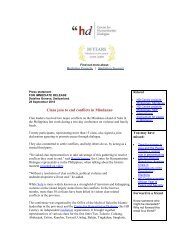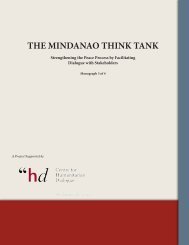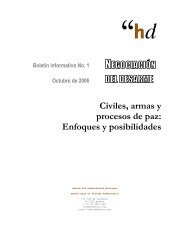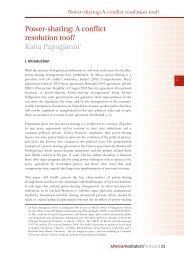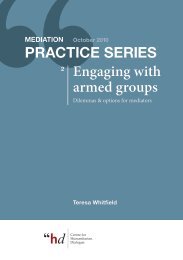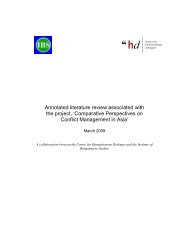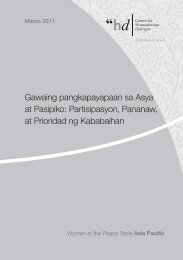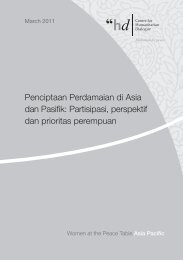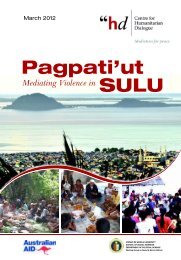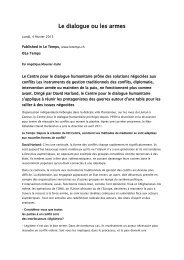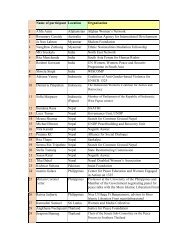Conflict Management in Indonesia â An Analysis of the Conflicts in ...
Conflict Management in Indonesia â An Analysis of the Conflicts in ...
Conflict Management in Indonesia â An Analysis of the Conflicts in ...
You also want an ePaper? Increase the reach of your titles
YUMPU automatically turns print PDFs into web optimized ePapers that Google loves.
y most actors <strong>in</strong>clud<strong>in</strong>g <strong>the</strong> OPM and <strong>the</strong> security<br />
services. In 2007, <strong>the</strong> TNI started an <strong>in</strong>formal<br />
exchange with local human rights NGOs on how<br />
to translate <strong>the</strong> concept <strong>in</strong>to reality. 105 At <strong>the</strong> end <strong>of</strong><br />
2007 religious leaders aga<strong>in</strong> declared that conflicts<br />
should be settled peacefully through a jo<strong>in</strong>t conflict<br />
resolution process <strong>in</strong>volv<strong>in</strong>g <strong>the</strong> government and<br />
<strong>the</strong> Papuans, facilitated by a neutral third party.<br />
A comprehensive evaluation backed by <strong>the</strong> government<br />
and Papuans on <strong>the</strong> implementation <strong>of</strong> <strong>the</strong><br />
autonomy law was suggested, as was prioritis<strong>in</strong>g<br />
<strong>the</strong> proper implementation <strong>of</strong> <strong>the</strong> autonomy law<br />
over creat<strong>in</strong>g new prov<strong>in</strong>ces or regencies <strong>in</strong> Papua.<br />
LIPI Road Map<br />
More recently LIPI, a governmental research body<br />
tasked with advis<strong>in</strong>g <strong>the</strong> government on policy<br />
matters, produced a detailed proposal – The Papua<br />
Road Map – for an <strong>in</strong>clusive dialogue process led<br />
by <strong>the</strong> government and possibly facilitated by an<br />
impartial third party. 106<br />
The Road Map identifies four root causes <strong>of</strong> <strong>the</strong><br />
conflict:<br />
The marg<strong>in</strong>alisation <strong>of</strong> <strong>in</strong>digenous Papuans,<br />
particularly economically, tak<strong>in</strong>g <strong>in</strong>to account<br />
<strong>the</strong> effects <strong>of</strong> transmigration;<br />
The failure <strong>of</strong> development programmes <strong>in</strong> Papua<br />
to prevent economic marg<strong>in</strong>alisation;<br />
Fundamentally diverg<strong>in</strong>g understand<strong>in</strong>g <strong>of</strong> history<br />
between Jakarta and Papua;<br />
A legacy <strong>of</strong> state-sponsored violence aga<strong>in</strong>st<br />
Papua. 107<br />
LIPI suggests a “New Papua” approach through<br />
affirmative policies that empower Papuans. LIPI<br />
105 Braithwaite, John et al., (2010), p.94.<br />
106 Widjojo, Muridan (Ed.), (2009). The <strong>Indonesia</strong>n version <strong>of</strong> <strong>the</strong> book<br />
was launched on 30 June 2009 by <strong>the</strong> M<strong>in</strong>ister <strong>of</strong> Defence Juwono<br />
Sudarsono. In 2010 <strong>the</strong> book was published <strong>in</strong> English jo<strong>in</strong>tly by<br />
LIPI, Yayasan Obor <strong>Indonesia</strong>, KITLV Jakarta-Leiden and ISEAS<br />
S<strong>in</strong>gapore. Its executive summary was circulated on <strong>the</strong> <strong>in</strong>ternet <strong>in</strong><br />
Bahasa <strong>Indonesia</strong> and English a year before its publication and has<br />
attracted positive <strong>in</strong>ternational, national and local responses.<br />
107 This violence resulted from a long-stand<strong>in</strong>g military-security approach<br />
to govern<strong>in</strong>g Papua motivated by fears <strong>of</strong> a separatist attempt to break<br />
away. This approach has been backed by <strong>the</strong> nationalists <strong>in</strong> Jakarta<br />
that dom<strong>in</strong>ate both <strong>the</strong> civilian and military bureaucracy, and has<br />
cont<strong>in</strong>ued through <strong>Indonesia</strong>’s transition to democracy. There have<br />
been persistent allegations <strong>of</strong> violence aga<strong>in</strong>st alleged separatist<br />
leaders, for example: The 2009 kill<strong>in</strong>g <strong>of</strong> Papuan guerrilla leader<br />
Kelly Kwalik by Densus 88 has revived and re<strong>in</strong>forced resentment<br />
towards Jakarta, especially among young Papuans from <strong>the</strong> highlands.<br />
recommends dialogue as a means for build<strong>in</strong>g a<br />
shared understand<strong>in</strong>g about <strong>the</strong> roots <strong>of</strong> <strong>the</strong> problems.<br />
It dist<strong>in</strong>guishes between four levels <strong>of</strong> dialogue:<br />
national dialogue between <strong>the</strong> GoI and Papuans,<br />
dialogue among Papuans <strong>in</strong> Papua, <strong>in</strong>formal dialogue<br />
among <strong>the</strong> Papuan elites, and <strong>in</strong>ternational<br />
dialogue between representatives <strong>of</strong> <strong>the</strong> GoI and<br />
Papua with an <strong>in</strong>ternational mediator.<br />
In LIPI’s model, a pre-dialogue stage is needed<br />
to build support for a dialogue <strong>in</strong> <strong>the</strong> first place<br />
and establish terms <strong>of</strong> reference (ToRs). <strong>An</strong> <strong>in</strong>ternal<br />
dialogue follows to socialise <strong>the</strong>se ToRs and<br />
revise and f<strong>in</strong>alise <strong>the</strong>m. In terms <strong>of</strong> an agenda,<br />
LIPI suggests broach<strong>in</strong>g <strong>the</strong> issues <strong>of</strong> history and<br />
<strong>the</strong> political status <strong>of</strong> Papua, reconciliation and<br />
human rights, <strong>the</strong> failure <strong>of</strong> development, and<br />
marg<strong>in</strong>alization and discrim<strong>in</strong>ation.<br />
Its weakness may be that it is, at times, too academic.<br />
It focuses on policies <strong>of</strong> local authorities,<br />
neglect<strong>in</strong>g analysis <strong>of</strong> <strong>the</strong> GoI’s policies. Little light<br />
is shed on economic issues or <strong>the</strong> role <strong>of</strong> extractive<br />
<strong>in</strong>dustries and <strong>the</strong> TNI. The issue <strong>of</strong> religious tensions<br />
between Muslims and Christians, <strong>in</strong>duced<br />
ma<strong>in</strong>ly by <strong>the</strong> arrival <strong>of</strong> migrants from o<strong>the</strong>r parts<br />
<strong>of</strong> <strong>Indonesia</strong>, is not given enough attention.<br />
Not<strong>in</strong>g <strong>the</strong>se criticisms, <strong>the</strong> Road Map is a well<br />
considered and timely document. As LIPI is a state<br />
<strong>in</strong>stitution, it can more easily encourage o<strong>the</strong>r actors<br />
across <strong>the</strong> GoI to engage seriously with <strong>the</strong> idea <strong>of</strong><br />
dialogue than would be <strong>the</strong> case if it had been a<br />
civil society <strong>in</strong>itiative. To, date, it has produced a<br />
crucial <strong>in</strong>itial impetus to build support for dialogue<br />
<strong>in</strong> Jakarta and <strong>in</strong> Papua.<br />
The Tebay Bluepr<strong>in</strong>t for Dialogue<br />
In 2009, a Papuan Catholic priest and lead<strong>in</strong>g civil<br />
society figure, Fa<strong>the</strong>r Neles Tebay, launched an <strong>in</strong>itiative<br />
<strong>in</strong> Papua to promote dialogue between <strong>the</strong><br />
Papuan community and <strong>the</strong> Government <strong>in</strong> Jakarta.<br />
He underl<strong>in</strong>es <strong>the</strong> need for dialogue, stress<strong>in</strong>g that<br />
violence will not solve <strong>the</strong> conflict, special autonomy<br />
has failed and <strong>the</strong> government is los<strong>in</strong>g <strong>the</strong> support<br />
<strong>of</strong> both Papuans and <strong>the</strong> <strong>in</strong>ternational community.<br />
He holds that both parties must demonstrate will<strong>in</strong>gness<br />
for dialogue and re-establish trust.<br />
Tebay suggests hold<strong>in</strong>g <strong>the</strong> dialogue under <strong>the</strong><br />
‘Land <strong>of</strong> Peace’ umbrella. He expla<strong>in</strong>s that, before<br />
dialogue is possible, <strong>in</strong>ternal dialogue among<br />
<strong>in</strong>digenous Papuans, between <strong>in</strong>digenous and non<strong>in</strong>digenous<br />
Papuans, and between Papuans <strong>in</strong> Papua<br />
and those <strong>in</strong> exile, must take place. He argues that<br />
<strong>An</strong> <strong>An</strong>alysis <strong>of</strong> <strong>the</strong> <strong>Conflict</strong>s <strong>in</strong> Maluku, Papua and Poso<br />
39



